REMEMBER THEIR NAMES
MEET THE 10 TREMENDOUS TALENTS MAKING THEIR MARK IN THE SESSION WORLD. TRUST US, THEY’RE GOING PLACES. . .
FRAZER WALLACE THE HAUS STUDIO
@FRAZERHAIR
Talk us through your journey into session styling and working backstage at fashion shows. Where did it all begin?
It all started in 2013 with the ghd Style Squad – the first one ever! I paused around 2017 to focus on hair education. Then my friend Carlo Avena gave me my big break, suggesting I assist Eugene Souleiman. I’ve been with them ever since – huge thanks, Carlo!
What made you pursue session work alongside running your studio?
Session work awakened something in me – the freedom and expression are electrifying. My studio is my baby, but I love being pushed out of my comfort zone. I hate being a big fish in a small pond. The fashion world welcomed me with open arms – I belong there and can be 100 per cent myself.
Any advice for balancing session work with your studio?
Don’t bite off more than you can chew! Take time off during busy periods like September and February, or you’ll end up moving a week of clients for shows – stressful!
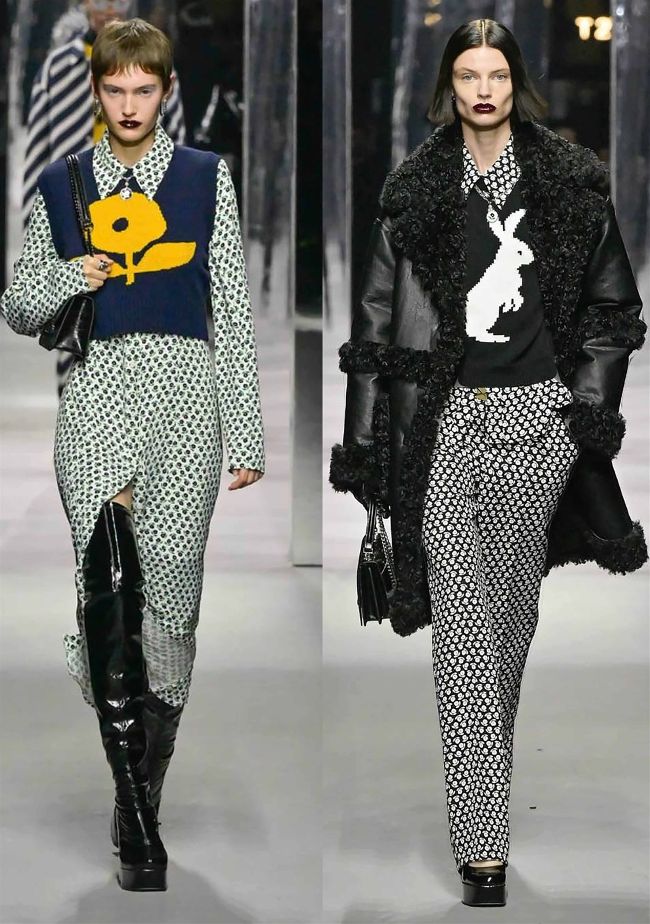
UNITED COLORS OF BENETTON, HAIR LEAD EUGENE SOULEIMAN
What’s one thing you’ve learned from session styling that you apply to The Haus Studio?
Feeling matters. You can be technically perfect, but if there’s no feeling, it’s pointless. Perfection isn’t always the goal.
Working with both Eugene and Guido is huge! How did those opportunities come about?
I’m truly privileged to have helped them realise their visions. Guido was through the Scottish agency Colours, while Eugene came through my friend Carlo.
What are some of your favourite shows and why?
Dior with Guido in Scotland was insane! But my proudest moment? Vogue World with Eugene in Paris. The atmosphere, the iconic models, the fashion pieces – it was electrifying. I’d told myself at 17 that working with Vogue meant I’d made it. Now, at 30, I’ve done it.
Anything surprising about working backstage? Everyone is REALLY nice!
What’s been your career highlight so far?
Vogue World, hands down!
Your advice to hair pros wanting to break into session work?
Study! Know fashion, know references and leave your ego at home. Listen, watch and practise when you’re back home. Don’t experiment on a major fashion show! Be skilled, be nice and check out sessionkit.com for tools.
If you could give a message to 16-year-old Frazer, what would it be?
You’ll find your home in hair. Trust your gut, because it’ll open doors you never knew existed. Hair will set you free – it’ll let you travel, take care of your family and build a beautiful career. You deserve your success!
ALISTAIR JUBBS CURATED HAIR
@MRJUBBS
Talk us through your journey into session styling and working backstage at fashion shows. Where did it all begin?
My session career started during my time with The Fellowship’s FAME Team. Nick Irwin, our course leader, sparked my passion for session work by allowing us to join his team for London Fashion Week shows. I got hands-on experience and learned the importance of intricate, deliberate referencing behind each show.
What made you decide to pursue session work alongside running your salon?
Session work is storytelling and social progression through hair – something I love bringing into my salon. Sharing those fashion-forward inspirations in a salon setting is everything to me. It breaks the exclusivity barrier and empowers everyday people.
What’s your advice for juggling both?
It’s a sacrifice. During fashion season, it can be back-to-back for a month – 12-hour salon days followed by a night bus to Paris for a show, only to return for another long day with clients. But my clients are my biggest supporters, and that flexibility makes it possible.
What’s one thing you’ve learned from session styling that you apply to your work at Curated?
Understanding your client/model/guest is everything. In the session world, looks are based on detailed references. Nick always said, “Eyes first, hands second”. At Curated, we focus on getting aligned with our guests before starting. Our product range is inspired by my session kit – what actually works, not just what’s trendy.
You often work as Nick Irwin’s right hand. How did that opportunity come about?
After my year with the FAME Team, I assisted Nick on editorials and learned his method and work ethic. I always said yes to opportunities, no matter how late or how booked I was in the salon. The fashion industry works on a different schedule, and adapting is key. My motto: say yes, figure out the logistics later.
What are three of your favourite shows you’ve worked on and why?
Noki – the cast was a diverse group of friends who believed in Noki’s anti-consumerism philosophy. It made the show powerful, especially in today’s world.
Labrum – last season celebrated immigration and the global community, a fusion of design in both hair and clothing. Burberry – my first season with Jawara involved creating a tortoiseshell hair colour on talent for Ricardo’s vision. After 10 hours of colour work, we nailed it.
What surprised you about working backstage?
I once got stabbed with a pencil by a production member during a line-up in Milan – definitely a surprise! You need to be prepared for anything. Sometimes the whole direction changes last minute, so flexibility is key.
What has been your career highlight so far?
Creating a full wig story for Bimini just before they appeared on RuPaul’s Drag Race was a huge highlight. It pushed my creativity and gave me the freedom to build a whole story around Bimini.
What’s your advice to hair pros wanting to get into session work?
Find artists whose style you love, and offer to assist them, even if it’s unpaid. Use Instagram to connect with the industry. Choose projects that inspire you but push you out of your comfort zone. Build a network – it may start with expenses-paid work, but it leads to bigger opportunities.
If you could give a message to 16-year-old Alastair, what would it be?
Don’t be so hard on yourself. Yes, mastering technique is important, but it’s always about feeling first. A perfect line doesn’t matter if it’s in the wrong place.
LEE DEVLIN
@LEEPATRICKDEVLIN
Talk us through your journey into session styling and working at Fashion Week. Where did it all begin?
I expressed an interest in wanting to get into session work when doing my apprenticeship at Paul Watts. He pushed me to apply for the The Fellowship’s ClubStar Art Team where I met Ellie Bond as one of the judges. Not long after meeting Ellie, I began assisting her and I still assist her regularly to this day.
Ellie has been a great mentor and has helped me in so many ways, offering sound advice and guidance. Ellie was my ‘in’ for the first-ever shows I worked at, and over the last few seasons, we’ve ended up on more shows together. I am very appreciative of the support she’s given me over the years, I’m glad we met and have become good friends.
What made you decide to get into session work as well as working in the salon?
I enjoy the balance for the most part. Your days in the salon can be very structured and you can just tick along having nice chats with clients and your day rarely becomes hectic or overly stressful. Then you go work on a show or a shoot where EVERYTHING goes wrong and there’s crying, swearing and a couple of thrown hairdryers, but at the end of the day it always works out and you can’t wait for the next one.
Also, as a side note, money. I spent years assisting and working on shows and shoots for next to nothing (sometimes nothing!) and if you want to keep that roof over your head you’ve got to try and sustain the two until you’ve got the wheels in motion.
What’s your advice for juggling the two?
The biggest thing I found was that you need to be frank with clients who book in that your schedule will constantly be changing. If they can be flexible and understand you might have to move appointments, it’ll keep everyone happy. You need to be working in a salon or space, whether you’re freelance or employed, where the owner(s) are cool with the fact you’ll be dipping in and out. Thankfully I have been blessed having worked at Paul Watts and Blue Tit London where they’ve been very understanding.
What’s the main thing you’ve learned from session styling that you apply to your work at Blue Tit?
In a nutshell, it’d have to be your overall styling skills. You learn so many ways to skin a cat and you might’ve been doing one thing a certain way for years, but then you assist someone who does it in a completely different way twice as fast, and
you then use that in the salon.
What have been three of your favourite shows you’ve got to work on and why?
Huge question that… the three that spring to mind would be Mains led by Ali Pirzadeh, Gucci led by Duffy and Yuhan Wang led by Adam Garland All for different reasons but I loved working with all the leads. They were all great designers, with loads of fun hair to do and a good after-party is always a welcome treat.
Is there anything which surprised you about working at Fashion Week?
It can be hard and fast. You’ve got to have your head screwed on and be pragmatic. There are a million things that need doing 10 minutes ago and you’ve got to keep your lid on.
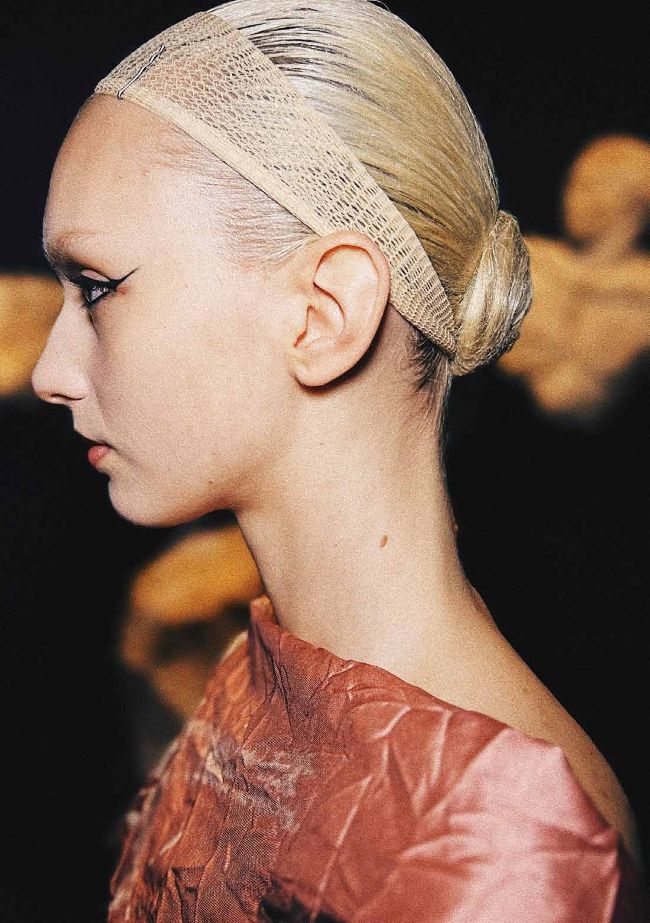
ERDEM, HAIR LEAD ADAM GARLAND
What has been your career highlight to date?
If I had to pick just one thing it’d be finalising for The One To Watch and The Editorial Stylist at Creative HEAD’s It List Awards. I remember looking at the magazine and seeing the awards when I started hairdressing thinking it’d be cool to enter one day, and now I’ve finalised for two categories! I’ve made so many great friends along the way and it’s nice to look back and see the progress I’ve made.
What do you hope to achieve with your session styling in the next five years?
That’s a tough one! I feel like I’ve only just found my feet in this world over the last year, and I do still feel pretty green. I’ve started getting a decent amount of my own work, but I’ve got a long way to go. I’d be happy to get some good jobs under my name and get to the point where I think I’m a good stylist.
What’s your one piece of advice to other hair pros who want to work in session but don’t know where to start?
I benefited massively from being involved with The Fellowship, having done ClubStar and Project X I met most of the people who have given me a leg up in those years and my network has grown from there. Doing shows has also been a huge part of my networking, I’ve made so many great friends from Fashion Week and I wouldn’t have had half the opportunities if I never started doing shows.
If you could give a message to 16-year-old Lee, what would it be?
Do what you want to do, not what you think you should do.
EMMA VICKERY PERCY & REED
@EMMAVICKERY095
Talk us through your journey into session styling and working at Fashion Week. Where did it all begin?
It all kicked off during lockdown in 2021. Salons were closed, but you could still work on set or test shoots. I took every opportunity – working with model agencies, make-up artists and photographers – and things grew from there.
Any tips for balancing session work with the salon?
Lots of opportunities come in last minute, but I always prioritise my salon clients – they’re my bread and butter. That way, I can choose session work that really excites me instead of just doing commercial gigs.
What have you learned from session styling that you apply to Percy & Reed?
Definitely how to style. Styling on set is so different from the salon, and I’m still learning!
What’s been your favourite session experience and why?
Honestly, I love the learning experience every time. You never know what doors will open just by showing up.
Anything surprising about Fashion Week? Not surprising, but definitely the chaotic organisation. You’d think after months of planning, things would run smoother!
What’s been the highlight of your career so far?
Leading my first team for the Adrianne Weber S/S23 show, and then doing it again the next season.
What’s your goal for the next five years in session styling? Quality over quantity. I want to do great work with great people in great environments.
One piece of advice for hair pros wanting to get into session work?
Just start! Reach out to photographers and model agencies and build a team of people you love working with.
What advice would you give 16-year-old Emma? Keep going, don’t stop, be relentless and only produce work you’re truly proud of.
IT LIST
THE ONE TO WATCH 2024
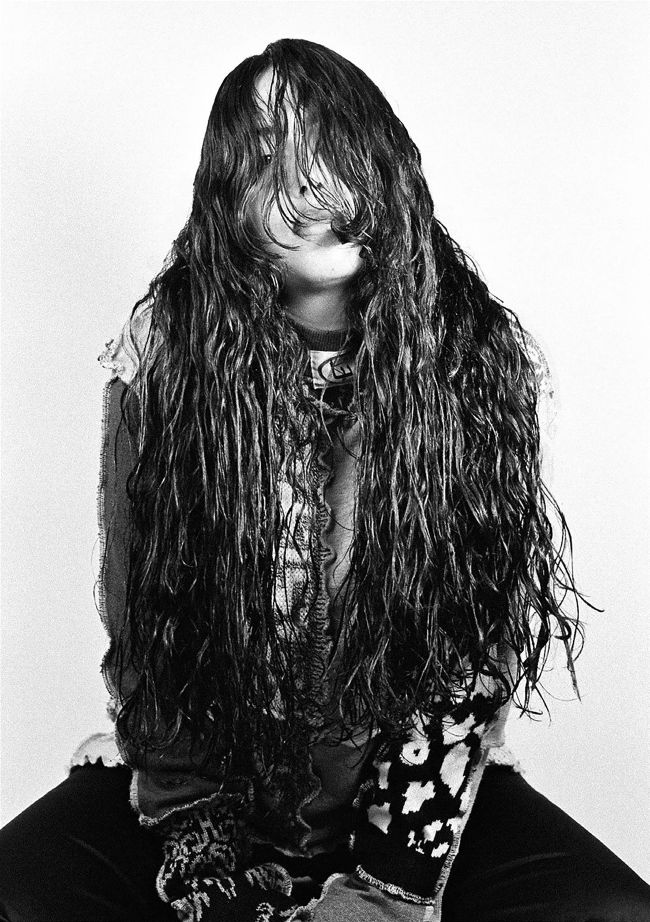
PHOTOGRAPHY BY YELIZ ZAIFOGLU
YASEMIN HASSAN WOOLF KINGS X
@YASEMINHASSAN95
Talk us through your journey into session styling. Where did it all begin?
I started my career as a salon stylist and had the chance to assist Joe Mills on a shoot early on. That experience showed me a completely different side of hairdressing. After attending a Kevin Murphy session styling course, I fell in love with the creative process – building mood boards, conceptualising ideas, finding models, and bringing it all to life.
I began moodboarding what I wanted to achieve and started assisting hairstylists I admired, like Matthew Tharp, who really shaped me into the hairdresser I am today. We worked with up-and-coming brands, put ourselves out there, and that’s where the real learning happened. Matthew and Joe have been amazing mentors, encouraging me to develop my ideas and collaborate with creative teams. I’ve since built a network, and, in April, I exhibited my first photography series in London.
What made you decide to pursue session work alongside salon work?
I wanted something that constantly pushed me out of my comfort zone. Working in a salon five days a week can sometimes feel repetitive, and session work allows me to experiment, stay on top of trends, and try new techniques. I think the two go hand in hand – what I do on set helps elevate my in-salon work, and vice versa.
What’s your advice for balancing the two?
Take risks. Yes, sometimes you don’t get paid for session work when you’re starting, but those opportunities build your portfolio and open doors for bigger projects down the line. It’s all about investing in yourself.
What’s the main thing you’ve learned from session styling that you apply to your work at Woolf Kings X?
Creative direction, for sure. Session styling pushes you to see the final look and guides you to achieve it, which is something I bring to my salon work. Plus, organising shoots and exhibitions has improved my people skills, and clients love hearing about my creative projects. In fact, many of my clients even helped shape my exhibition this year, offering their time and advice. It’s all about building community.
What have been three of your favourite shoots or shows you’ve worked on and why?
Mowalola with Cynthia Harvey’s team – this was my first show, and I’ve always admired Cynthia’s work, especially her exhibition at the Wellcome Gallery. The energy in the room was intense, but it was such an amazing atmosphere.
Charlie Constantinou with Matthew Tharp’s team – this was Charlie’s first LFW show, and he was so passionate about the entire process. It was such a hands-on experience with an intimate team, and the complex looks made it even more exciting.
Talking Textures shoot two – this was my own project, with five models, each with a unique look. The team was amazing, and the energy on set was unmatched. The shoot was long, but the vibe made it all worth it.
Anything that surprised you about working at Fashion Week?
I always knew it would be high-pressure, but the energy is on another level! One thing I didn’t expect was how important hair prep is – it’s crucial to the entire process.
What has been your career highlight to date? Launching Talking Textures, a photography series that challenges Eurocentric beauty standards within the Southwest Asian North African community. The project featured 13 models, seven concepts, and a test shoot, all shot on analogue film. I curated the entire series and exhibited it in London, showcasing 49 editorial photos and attracting more than 700 people in one weekend. It was a huge achievement for me.
What do you hope to achieve with your session styling in the next five years?
I want to continue expanding Talking Textures with more shoots and exhibitions. I’m currently working with an arts festival to curate the next series, with a bigger budget and a larger creative team. It’ll be showcased next June, and I’m collaborating with emerging designers and models. I also hope to work on more shows and eventually make it to Paris and Milan Fashion Weeks.
What’s your advice to other hair pros who want to break into session work but don’t know where to start?
Start by creating your collections, assist the people you admire and don’t be afraid to reach out. Collaborate with other creatives – photographers, make-up artists – and build something unique for your portfolio. Networking is key.
If you could give a message to 16-year-old Yasemin, what would it be?
Never say never and take risks because the craziest things can happen.
MIKE MAHONEY JOSH WOOD
@MIKEMAHONEY.HAIR
Talk us through your journey into session styling and working at Fashion Week. Where did it all begin?
I started in a salon in Camden, surrounded by fashion and culture, which gave me a lot of inspiration. While training, I assisted the creative team on shoots, and that’s when I caught the buzz for session work. I followed session stylists like Gary Gill, whose punk and anti-hair influence really spoke to me. Then, my friend Carlo Avena and I launched Fuzed London, collaborating with young creatives and putting ourselves out there in the fashion world. After a few years, we headed up some London Fashion Week shows, which was a huge career highlight for us.
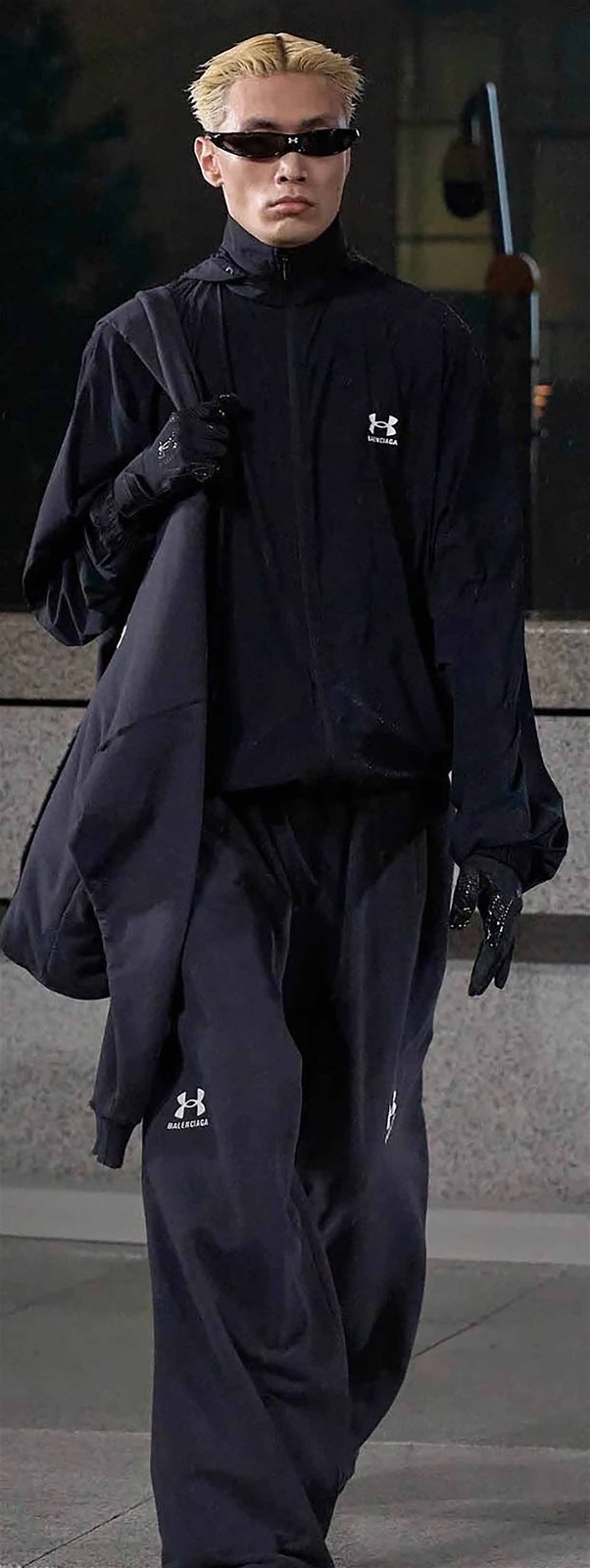
BALENCIAGA SHANGHAI, HAIR LEAD GARY GILL
What made you decide to pursue session work alongside salon work?
I love balancing both because I’ve built a strong clientele of amazing, cool people that I enjoy seeing regularly. But I also love the freedom of travelling for session work – it keeps things exciting, and I stay inspired.
What’s your advice for juggling the two?
Find a salon that supports your creative goals. If your boss isn’t letting you grow and inspire yourself, you’re in the wrong place. I’ve always been lucky to work in salons that value creativity and what it brings to their business.
What’s the main thing you’ve learned from session styling that you apply at Josh Wood Atelier?
Having a cool, creative clientele makes your work life easier. Being at the forefront of fashion allows you to bring those styles and energy into the salon naturally.
How did you come to join Gary Gill’s core team?
Tom Wright, Gary’s first assistant at the time, saw my work with Fuzed London and invited me to assist on an editorial shoot. That led to me joining Gary’s show team, and after five years, I became part of his core team.
What are three of your favourite shows and why?
Balenciaga Shanghai show – it was incredible to be in a completely different part of the world and have my work on a Shanghai runway.
All Martine Rose shows – I can’t choose just one because the vibe, energy and hair we create are amazing every time. I love how the brand reflects London’s culture and fashion. Hermès Paris shows – working on luxury shows like Hermès is special. Creating clean, expensive-looking hair with Gary’s aesthetic on a high-end runway is always fascinating.
Anything that surprised you about Fashion Week?
The hours! You really have to work hard to keep a show season running smoothly, especially as part of a core team. What has been your career highlight to date?
Doing hair for a wedding on a huge yacht in Capri, Italy. I was in the same waters where David Gandy filmed his Dolce & Gabbana advert – it was pretty rock ‘n’ roll.
What’s your advice for hair pros wanting to break into session work?
Be ready to start from the bottom, work hard, and take on every opportunity that comes your way.
If you could give a message to 16-year-old Mike, what would it be?
Life’s good, brother.
THE EDITORIAL ST YLIST 2024 IT LIST THE EDITORIAL ST YLIST 2024
MIMI KOBAYASHI BILLI CURRIE
@STYLISTMIMI
Talk us through your journey into working at Fashion Week. Where did it all begin?
I’ve always been captivated by Fashion Week, so when a product company was looking for a hair team, I jumped at the opportunity. After auditioning, I was thrilled to be invited to join. My first Fashion Week in 2017 was truly a dream come true.
What made you decide to work backstage as well as in the salon?
Hairdressing has so many facets, and I wanted to explore them all. Fashion Week allows me to push my creativity and expand my skills. I’m so lucky that my directors, Billi and Debbie, have been incredibly supportive throughout my journey.
What’s your advice for juggling both? Stay humble, work hard and have fun. Balancing salon work with the demands of Fashion Week takes dedication, but enjoying the process and staying grounded makes it all worthwhile.
What’s the main thing you’ve learned from Fashion Week that you apply at Billi Currie?
Teamwork. Fashion Week isn’t about individual success – it’s about making the show shine. I bring that mindset to Billi Currie, always thinking ahead, helping my team and being their biggest supporter.
What are three of your favourite shows you’ve worked on and why?
Jasper Conran with Samantha Hillerby – it was my first Fashion Week experience. I was nervous, but the support from the team was amazing.
Emilia Wickstead with Benjamin Muller – being chosen to work closely with Benjamin was a major career highlight for me.
Sinéad O’Dwyer with Anna Cafone – the teamwork was incredible, and it was the first LFW show where blind and low-vision women could fully experience the event, including backstage access.
Anything that surprised you about working at Fashion Week?
Once, we had to wash a model’s hair in a toilet sink just before a show because she came straight from another event. It was chaotic, but we made it work!
What has been your career highlight so far?
My biggest highlight has been working at Billi Currie for 13 years. Billi and Debbie have always supported me, allowing me to collaborate with product companies and pursue other opportunities. It’s wonderful to have such a strong, warm home base.
What are your career goals for the next five years?
I’m from Japan, and even after 17 years in the UK, I’ve always wanted to share British hairdressing skills with my home country. My goal is to become a bridge and introduce some of the best techniques to Japan.
What’s your advice to other hair pros wanting to break into session work?
Practice, practice, practice. A strong foundation is crucial. Building connections is just as important, and social media makes that easier than ever. Keep your profile updated, network actively and don’t be afraid to reach out.
If you could give a message to 16-year-old Mimi, what would it be?
Don’t be afraid of making mistakes – they’re vital for learning. You’ll encounter many teachers along the way, each with their own methods.
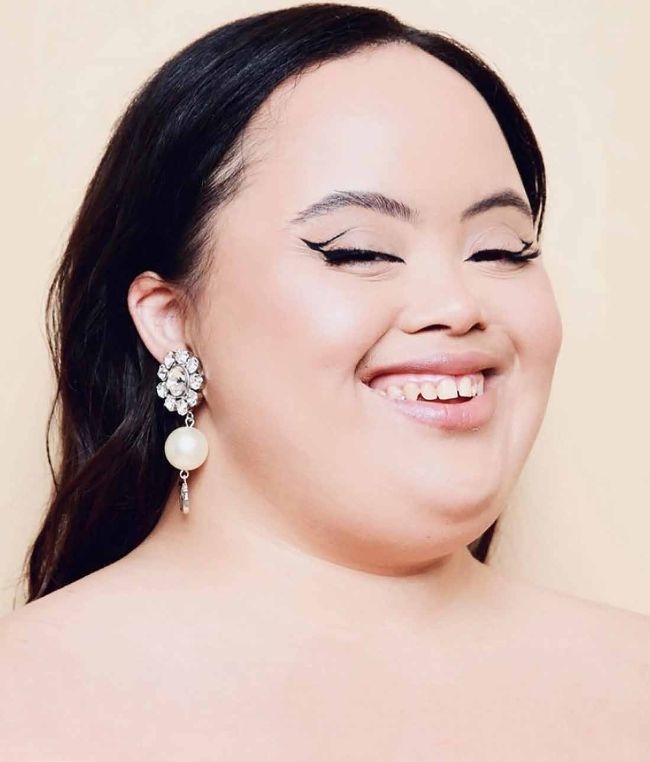
IMAGE FROM VOGUE
MICHAEL A BODEN
@MICHAELABODDEN_
Talk us through your journey into session styling and working at Fashion Week. Where did it all begin?
My journey started in 2019. I was losing my passion for salon life, and I wanted to explore my creativity more, so I started collaborating with photographers, make-up artists and stylists through Instagram to create a portfolio and network. I was lucky enough to build a network of creatives who would recommend me in rooms of opportunity, and that led me to get my first leading role at LFW for eyewear designer Victor Wong in 2019.
What made you decide to get into session work?
I first went into session work after realising I wanted to be more creative than I could be in the salon. After my first shoot, I fell in love with being on set and realised I had a real passion for it, and I could also make a difference as there was a limited number of hairstylists that catered to all hair textures.
What have been three of your favourite shows/shoots you’ve got to work on and why?
Burberry S/S24, Ahluwalia S/S24 and a job for Alicia Keys in which she redid her song If I Ain’t Got You with an allwomen-of-colour orchestra.
Is there anything which surprised you about working at
Fashion Week?
The thing that always surprises me at every show is how it all comes together so perfectly at the end. Backstage can be chaotic at times but watching the show no one will ever know the processes we go through behind the scenes.
What has been your career highlight to date?
There are a few but if I was to pick one, I would say it was being one of the finalists for the It List Awards in 2023. Entering myself for the first time put my career into perspective. When putting together my entry it encouraged me to reflect on all the moments in my career that I’m so proud of, how far I’ve come and how far I still want to go.
What do you hope to achieve with your session styling in the next five years?
Something that has been on my bucket list is doing hair for a hair campaign/brand and I would love to do more shows at the different fashion weeks, especially in New York. I’d also love to be able to lead more shows.
What’s your one piece of advice to other hair pros who want to work in session but don’t know where to start?
Your network is your net worth!
If you could give a message to 16-year-old Michaela, what would it be? Be patient and keep working hard, your dreams are never too wild or big.

MICHAELA (RIGHT) WITH ROSIE-GRACE SMITH AND NAT BURY
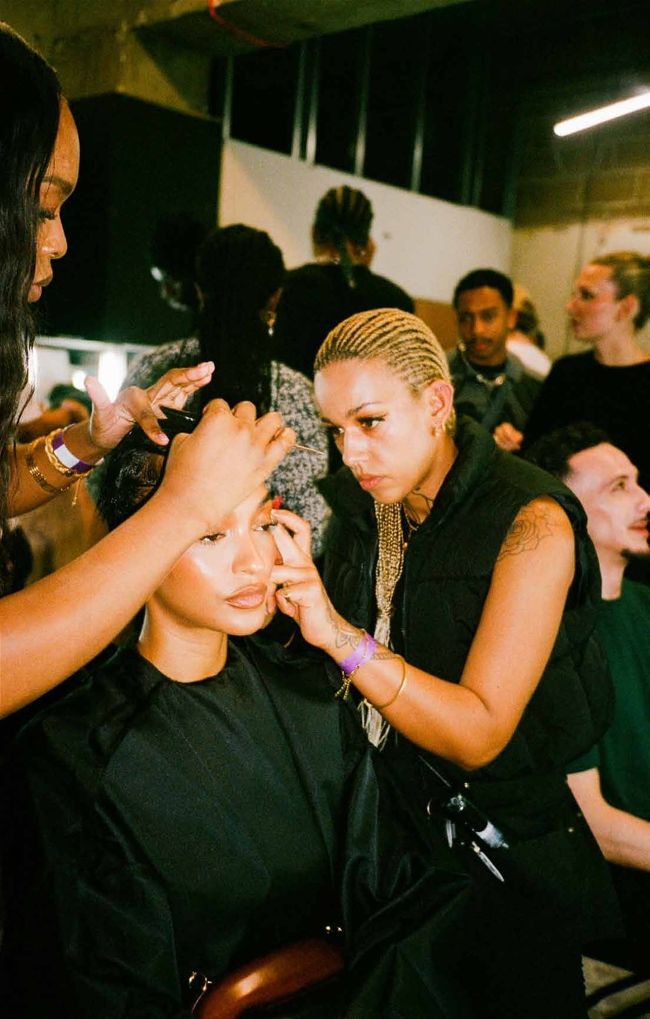
ROSIE-GRACE STYLING HAIR OF JORDAN DUNN FOR SAUL NASH SHOW
ROSIE-GR ACE SMITH
@HAIR.BY.ROSIE.GRACE
Talk us through your journey into session styling and working at Fashion Week. Where did it all begin?
I’m trying to recall my very first shoot, and I think I remember the feeling more than anything else – just pure anxiety. Shoots are about creating moments and capturing eras, which is a far cry from doing a classic bob on a Barbra in the local salon. I took whatever work I could find, often for cheap or just expenses, and kept at it!
You’ve worked with iconic hair artists like Cyndia Harvey and Nick Irwin, which is no small feat! How did you come to be part of their teams?
Honestly, it was all about good timing! I’m not entirely sure how it all came together – someone passed along my email, and from there, things just organically fell into place.
How have you found the transition from working at Bebop to being a full-time session and braid artist?
Bebop was so supportive during the transition, especially in helping me with the logistics – like emailing and discussing rates. The biggest difference is that I now have control over my time, which suits me well.

KNWLS S/S24, HAIR LEAD CYNDIA HARVEY
What have been three of your favourite shows to work on and why?
Casablanca with Cyndia Harvey – this was just iconic. I was there for the prep day, and the wig I prepped looked amazing. Every time I saw that model, I felt like a proud momma! I met some incredible models and hairstylists that day.
Labrum with Nick Irwin – this was another iconic experience. I was in love with the clothes, the concept, and the team. The day was full of heritage, pride and all the good things. Mains with Ali Pirzadeh – this show was totally up my street. The line-up was insane, with so many talented people in incredible clothing. Yes, please!
Is there anything that surprised you about working at Fashion Week?
The early starts! The first time I saw a 5am call time I nearly passed out!
There’s still a lot of work to be done when it comes to textured hair and braids at Fashion Week, especially in terms of expertise on hand. What are your thoughts? As the industry becomes more inclusive with model choices, it’s great to see that reflected behind the scenes. There’s still room for improvement, but things are moving in the right direction.
What has been your career highlight so far?
Leading the Saul Nash show with Nat Bury has been a highlight for me. We really brought to life the vision of garage culture, and it was our third (I think!) season together with the designer, make-up, and hair teams. We had top models, artists and such great support. That season we truly upped our level and delivered. It’s so rewarding to see your own progression!
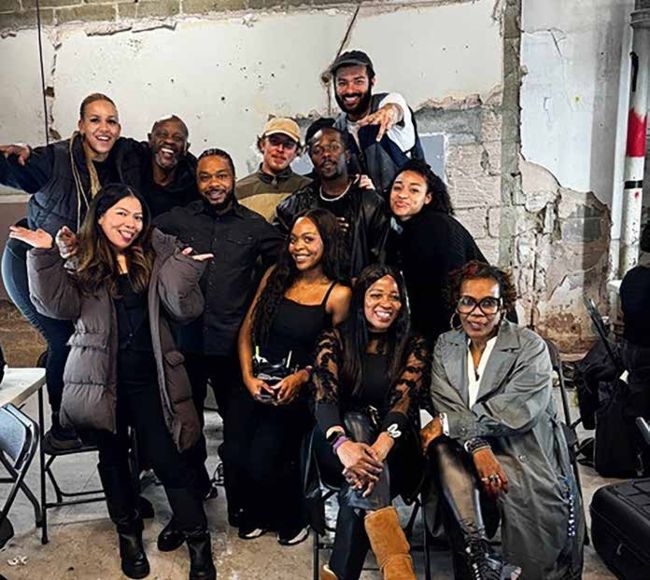
STILL FROM MUSIC VIDEO WITH BOB VYLAN
What do you hope to achieve with your session styling in the next five years?
I’d love to see my name printed in more magazines, maybe start a braiding course, and bring some of my concepts and ideas to the forefront.
What’s your advice for other hair pros who want to get into session work but don’t know where to start?
Reach out to photographers whose work you admire, skill swap, and COLLABORATE!
If you could give one piece of advice to 16-year-old Rosie, what would it be?
What you put in is what you get out – and stop relaxing your hair!
CARLO AVENA
@_CARLOAVENA
Talk us through your journey into session styling and working at Fashion Week. Where did it all begin?
I started session work about five years ago, but before that, I spent 10 years at HOB Academy in Camden, training and assisting Akin Konizi and his creative team. While I loved hair and education, fashion and culture have always been deep-rooted passions of mine. Growing up, I was drawn to publications like The Face, i-D and DAZED for their fusion of music and fashion.
My best mate, Mike Mahoney, and I launched Fuzed London as a creative outlet where we could showcase our style – raw cuts, stripped-back shoots and using real people as muses. Eventually, we found ourselves leading a couple of shows at London Fashion Week, which was a massive career moment for us.
I was always inspired by Eugene’s work, especially how he mixed punk and couture, so I pestered his agent for two seasons. Eventually, I got an email asking if I could be in Paris to assist Eugene’s team. I said yes, called my mum to send me clothes and my passport in an Uber, and went straight to Paris after work.
You’ve become Eugene’s first assistant – how did that happen?
I’ve only ever worked in Eugene’s team. With zero show experience, they took me in and trained me. For around four years, I made myself available solely for his team. We clicked instantly, bonding over music and our similar upbringings in London.
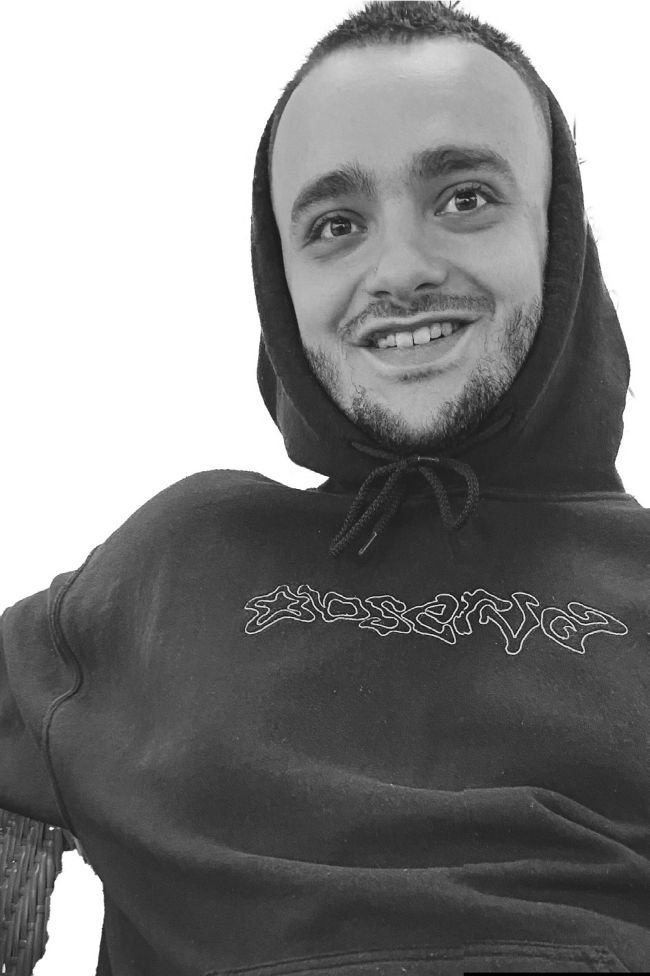
SINEAD GOREY
What’s the biggest lesson you’ve learned as an assistant that you apply when leading hair teams now?
As an assistant, you have to be a sponge – take criticism and learn from people’s experiences. As a lead, you still need to absorb, but now from designers, photographers and creatives. It’s about collaboration, building something together, and learning from each experience.
What are three of your favourite shows you’ve worked on and why?
Margiela Couture 2019 – it was my first show, so it has sentimental value, it was a completely new experience for me. Thom Browne Couture Fall 2023 – my first Thom Browne Couture show as first assistant. It was insane – tonnes of hair, preps and pressure, but so rewarding. We turned an Airbnb into a salon for five days of non-stop wig work.
Sinead Gorey A/W23 – my first show as a solo lead. It was extra special because Sinead is a close friend, and I met my girlfriend, who was the art director at this show.
Anything that surprised you about working at Fashion Week?
The sheer amount of luggage! We travel with 13 bags, each weighing 32kg, ready to build a studio anywhere in the world.
What’s your favourite fashion capital and why?
Milan. The vibes are always on point, and my favourite show there is Jil Sander. The brand’s minimalism is so well-balanced with music, set design and fashion. I’m a huge jungle and drum and bass fan, and last year they played a J Majik track during the show – it was epic!

FIGURA SERVICES
What has been your career highlight so far? Working on Edward Enninful’s last issue as creative director for British Vogue. The shoot was shot by Rafael Pavarotti, and the whole concept was centred around the cultural impact of the Amazon. The model, who was an Amazonian, reenacted a political speech and painted her face with war paint. It was an incredibly emotional and unforgettable moment.
What do you hope to achieve in the next five years with your session styling?
I want to push my creativity further by exploring different mediums, like making fashion films and launching a zine.
What’s your advice to other hair pros who want to get into session work?
Stay persistent – keep on your favourite hairdresser’s agent, assist as much as possible, and keep practising. I’m currently on holiday and still practising pleats on my girlfriend’s hair!
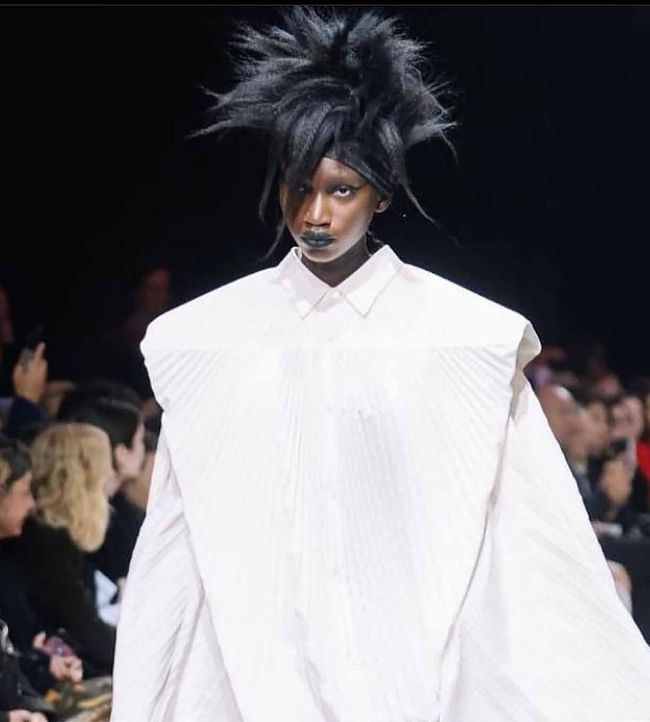
JUNYA WATANABE, HAIR LEAD EUGENE SOULEIMAN
If you could give a message to 16-year-old Carlo, what would it be?
Inspiration is everywhere, not just in hair. And don’t take numeracy and literacy for granted – you’ll need it for budgets, creative treatments, and communicating ideas. Basic maths and literacy will be more useful than you think.